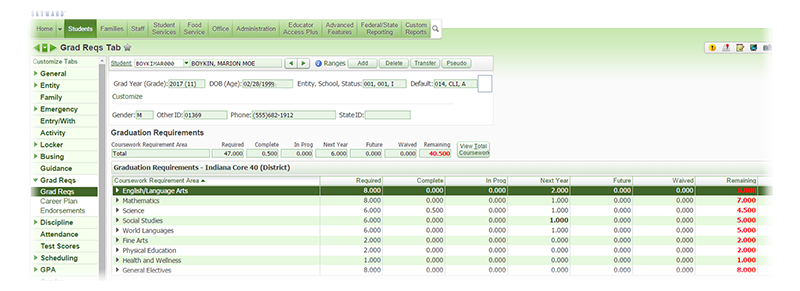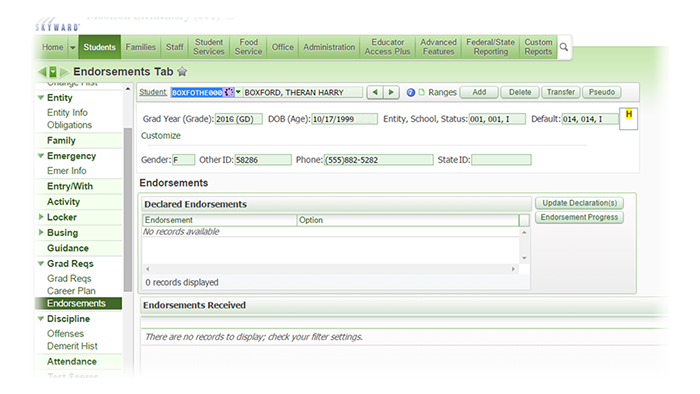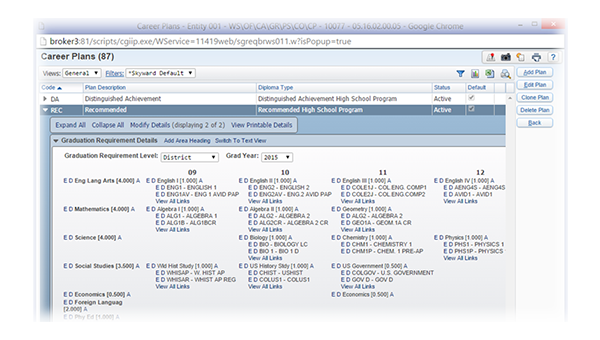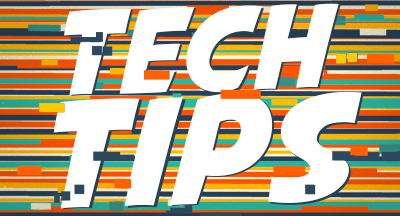College and Career Readiness in Skyward
|
Jacob Baumann Product Owner |
You know it’s important to be ready for any challenge that comes your way. But are you equipped for the ultimate challenge – ensuring the college or career readiness of each of your students? Let’s learn about three Skyward tools you can use to help your students gear up for life after high school.
Graduation Requirements
What it is: The Graduation Requirements feature makes it easier to keep students on track toward graduation by monitoring their progress in each coursework requirement area. This is an optional module, but many schools see it as a fundamental part of their college and career readiness plan.How it works: At the district level, schools complete a one-time graduation requirement setup. Administrators can tailor Graduation Requirements to their school’s needs by designating coursework requirements, diploma types, educational milestones, individualized plans, and other specifics. You can even import state graduation requirements directly into the program!
The benefits: No more flipping through clunky course catalogues or scrutinizing requirements for different graduation years. Graduation Requirements offers a snapshot of what needs to be done and what’s already been taken care of so your teens can make continuous progress toward their diplomas.
Graduation Requirements offers transparency, too. There shouldn’t be any surprises when graduation rolls around because it’s easy for everyone to see which requirements have been completed, which are in progress, and which remain incomplete.
Expert tips: After future scheduling has been completed, counselors can glance at Graduation Requirements to make smart scheduling adjustments. One screen offers a wealth of information, including the ability to make sure every class fulfills a remaining requirement.

If your state or district requirements for graduation change at any time after the initial setup is complete, you can incorporate new requirements for incoming students while still maintaining the previous requirements for students who are "grandfathered" in.
You can also run reports in Graduation Requirements to see if you have students who are credit deficient. Under Graduation Requirements, go to Reports, then select Student Coursework Requirements Report (SC).
Endorsements
What it is: The Endorsements feature allows students to declare an emphasis or concentration for their coursework – a bit like a college major, except Endorsements can be designed for both college and career preparation.Any school in any state can build Endorsements into its college and career readiness plan. Some states have pre-defined Endorsements. Texas, for example, has five different Endorsement options for students to pick from: Science, Technology, Engineering, and Mathematics (STEM); Business and Industry; Public Service; Arts and Humanities; and Multi-Disciplinary Studies.
How it works: Endorsements are located within Graduation Requirements. Most schools will begin by outlining and building the Endorsements they’d like to offer. Then students will log in to Student Access to declare an Endorsement early in their high school experience.
As students take classes, they can monitor their progress toward completing their declared Endorsement. The system will automatically keep track of progress toward any Endorsement, so if a student’s interests or goals change, he or she can easily switch Endorsements or even work toward achieving multiple Endorsements.
Bonus! If a student unintentionally achieves the requirements for an additional Endorsement, the system will recognize this and automatically award the additional Endorsement.

The benefits: Endorsements allow students to build a specific set of skills in an area of interest or talent. When graduation comes, students will already have experience selecting a path, monitoring progress toward a goal, and changing courses if necessary. This can help graduates more confidently transition into a career or a college major, knowing that (at least for now!) they are headed in the right direction.
Expert tips: Endorsements can become even more valuable when the community gets involved. Some schools have partnered with local businesses to build Endorsements that prepare students for existing job opportunities – a huge benefit for both the students and the community. You can even build apprenticeships, internships, and job shadow experiences into the requirements for achieving an Endorsement.
Career Plans
What it is: The Career Plan feature is the most systematic tool in this lineup. While Graduation Requirements and Endorsements both allow students to fulfill requirements in any order and at any time, a Career Plan shows a recommended four-year sequence of classes to take based on the student’s career goal.How it works: Like Endorsements, Career Plans are also located within Graduation Requirements. First, school administrators create templates for the Career Plans they’d like to offer. Some schools create templates for specific careers (Journalism, Computer Technology, Nursing, etc.) and others create more general templates.
Then, counselors can go to a student’s profile, assign a specific plan to their record, and start to build their sequence of courses. Since Career Plans are tied to the Curriculum Master, you can select all of the courses that build toward a student’s goal and deselect courses that are unnecessary or the wrong level of rigor.
The benefits: Career Plans can be a one-stop shop for students to see a detailed four-year plan that will help them work toward their career goals. Just like Endorsements, Career Plans can incorporate apprenticeships, internships, and job shadowing experiences.
In a school that offers many different ways to fulfill a general requirement, the Career Plan can help students select the specific classes that will best prepare them for their intended career or college major. Because of their sequential nature, Career Plans can also reduce the chance that students will overlook a prerequisite for an essential class.

Expert tips: Most schools that use Career Plans assign a plan to a student prior to the start of high school or within the first semester. Students get the most out of this tool when they can see the whole four-year view.
Since Career Plans are so detailed, make sure you schedule enough time to complete the setup process and to assign students’ plans. As you go, don’t forget to consult the PDC or SkyDoc for helpful videos and written instructions.
We hope this guide gives you a better understanding of some of the college and career readiness tools available to you and your students. If you have questions about which options will serve you best, don’t hesitate to contact us today.
Thinking about edtech for your district? We'd love to help. Visit skyward.com/get-started to learn more.
|
Jacob Baumann Product Owner |

 Get started
Get started





